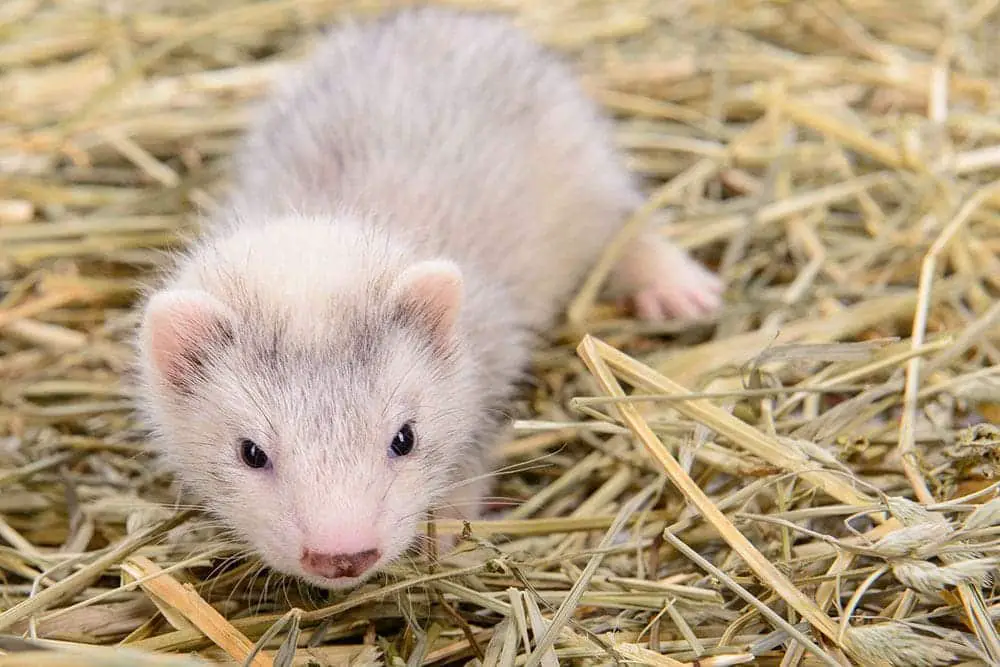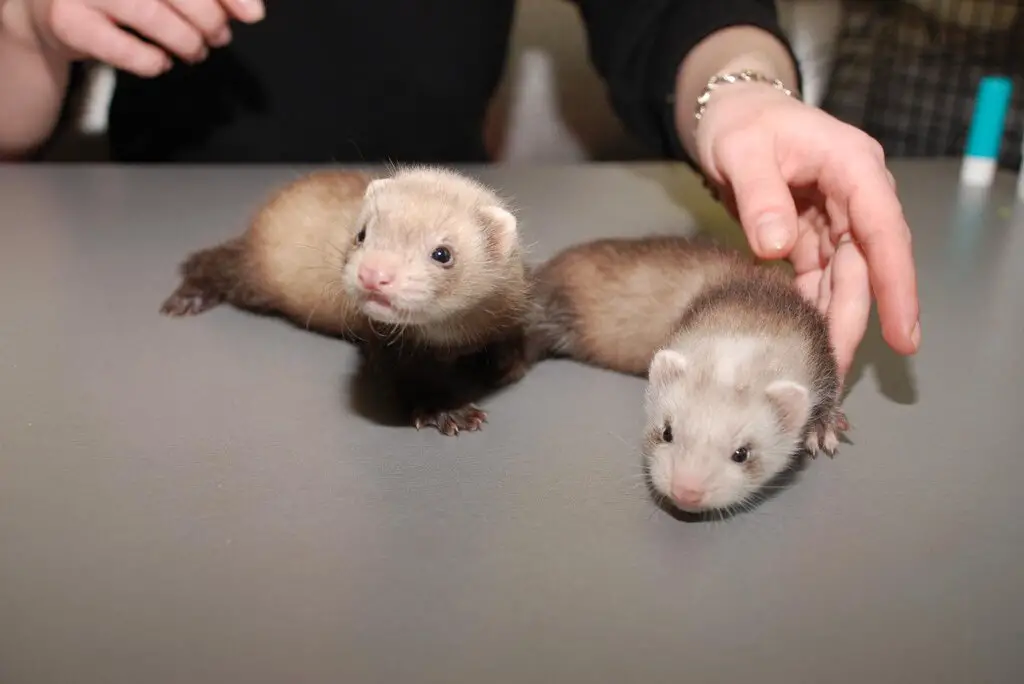Introduction
How To Litter Train Ferrets: Ferrets, those charming and mischievous little creatures, have become increasingly popular as pets in recent years. Their playful nature, inquisitive personalities, and endearing antics have won the hearts of many animal lovers. However, like any pet, ferrets animals come with their own set of responsibilities, one of which is ensuring they are well-behaved and clean. Litter training your ferret is a crucial aspect of their care, as it not only keeps your home smelling fresh but also fosters a harmonious living environment for both you and your furry friend. Litter training a ferret may seem daunting at first, but with patience, consistency, and the right approach, it can be a relatively straightforward process.
Litter training is a fundamental aspect of ferret ownership, as it contributes to a clean and hygienic living space. Ferrets are naturally inclined to be clean animals, which can work to your advantage during the training process. However, like all pets, they require guidance and reinforcement to learn the proper behaviors expected of them. Whether you’re a seasoned ferret owner looking to refine your training techniques or a newbie embarking on the adventure of ferret companionship, as your trusted companion in the journey of litter training.
We will begin by discussing the essentials of ferret litter and choosing the right materials to ensure your ferret’s comfort and well-being. Then, we’ll delve into the practical aspects of setting up a litter box and creating an environment conducive to successful training. Understanding your ferret’s instincts and behaviors is also crucial, so we’ll these aspects to help you anticipate their needs and tailor your training accordingly. With dedication, patience, and the insights provided, you can transform your ferret into a litter-trained companion, enhancing the bond between you and your furry friend while maintaining a clean and pleasant living space for both of you to enjoy.

Are ferrets hard to litter train?
But don’t let that put you off. Much to the surprise of some people, ferrets can be trained to use a litter tray/box, just like cats. They are very intelligent animals, and so with a bit of time and patience on your part, it can be done.
Younger ferrets tend to be more adaptable and may grasp litter training concepts more quickly. Older ferrets, particularly those who have not been previously trained, might require more patience.
Ferrets that have received some form of litter training before coming into your care might adjust more readily to your setup and expectations.
The personality of the ferret plays a significant role. Some ferrets are naturally more fastidious and may take to litter training with minimal effort, while others may be more independent and challenging to train.
The consistency and dedication of the owner or caregiver in maintaining a clean litter box and reinforcing positive behaviors can greatly impact the training’s success.
Why won’t my ferret use the litter box?
The short answer is because they are ferrets. Some ferrets are more fastidious about using the litter pan than others, so if they get distracted, or have a sudden urge, whatever corner is closest is good enough for them. The trick is to make the litter box more appealing than any other corner.
Before assuming a behavioral problem, it’s crucial to rule out any underlying medical issues. If your ferret suddenly stops using the litter box or has never used it consistently, consult with a veterinarian. Health conditions such as urinary tract infections or gastrointestinal problems could be causing discomfort, making it difficult for your ferret to use the litter box.
Ferrets can be picky about their litter, and they may avoid a litter box if they don’t like the type of litter you’re using. With different types of litter, such as recycled paper, clumping, or pellet-based litters, to see if your ferret has a preference. Some ferrets may prefer a certain texture or scent.
Ferrets are naturally clean animals and may refuse to use a dirty litter box. Ensure that you clean the litter box daily and change the litter regularly. A dirty or smelly litter box can discourage your ferret from using it.
Ferrets are sensitive animals, and stress or anxiety can affect their litter box habits. Changes in their environment, the introduction of new pets, or loud noises can all contribute to stress. Addressing the source of stress and providing a safe, secure environment can help your ferret feel more comfortable using the litter box.
What kind of litter do ferrets like?
Most experienced ferret owners and breeders have found that pelleted litters are the best choice. The pellets are heavy enough to remain in the litter pan when the ferret steps out. They contain much less dust than other litter types, they are highly absorbent, and they are easily scooped.
Paper-based litters are a popular choice among ferret owners. These litters are made from recycled paper and are typically non-toxic, biodegradable, and dust-free. They have a soft texture that is gentle on your ferret’s paws, making them comfortable for your pet to use. Paper-based litters also have good absorbency, helping to control odors effectively.
Pellet litters, often made from compressed recycled paper, can be another suitable option for ferrets. These litters are known for their absorbency and low dust levels. The pellets break down when they come into contact with moisture, which helps in keeping the litter box dry and odor-free. Many ferrets find the texture of pellet litter comfortable to walk on.
Clumping litters are made from materials such as clay or natural fibers and form solid clumps when they come into contact with moisture. While these litters can be effective at controlling odor and moisture, they are generally not recommended for ferrets. Ferrets are curious animals that may ingest the litter, and clumping litters can pose a risk if ingested, potentially causing gastrointestinal blockages.
Wood-based litters, often made from materials like pine or cedar, are another option. However, it’s essential to be cautious when using these litters with ferrets. Some wood-based litters release aromatic oils that can irritate a ferret’s sensitive respiratory system. It’s advisable to choose a low-dust, unscented wood-based litter if you opt for this type.
What pets are easiest to litter train?
Rabbits, guinea pigs, ferrets, rats and other small animals can all be successfully litter trained if the right steps are taken to encourage their training. Cat litters are not generally suitable for use with other small pets.
Cats are perhaps the most well-known and easiest pets to litter train. They have a natural instinct to bury their waste, making litter box training relatively straightforward. Cats often take to the litter box with minimal guidance, and their independent nature means they’re inclined to use it consistently.
Rabbits are surprisingly easy to litter train, especially if they are kept indoors. Like cats, they have a natural inclination to use a specific area for elimination. Providing a litter box filled with appropriate litter material, such as paper-based or pellet litter, and placing it in their enclosure can lead to successful litter training.
Guinea pigs are known for their small size and gentle disposition, making them popular pets. These rodents can also be litter trained relatively easily. Place a small litter box with suitable bedding in their cage, and most guinea pigs will adapt to using it for urination and feces.
Hamsters are small and relatively clean animals that can be litter trained to use a specific corner of their enclosure for waste. Providing a small container filled with a suitable substrate, like paper-based bedding, can encourage this behavior.
Can you litter train a 2 year old ferret?
“Usually ferrets like to relieve themselves in corners, and they don’t usually go where they eat or sleep. So, theoretically, a litter box in their favorite corner of the cage should work.” To start, Fiorella suggests training your ferret as young as possible, since babies usually take to the idea fairly easily.
Health Check: Before you begin litter training, it’s essential to ensure that your ferret is in good health. Any underlying health issues, such as urinary tract infections, could affect their litter box habits. Consult with a veterinarian to rule out medical problems.
Select the Right Litter: Choose a litter that is safe for ferrets, such as paper-based or pellet litter. Avoid clumping litters, as they can be harmful if ingested.
Set Up the Litter Box: Place a clean litter box in your ferret’s play area or wherever they spend most of their time. Ensure the box is large enough for them to comfortably enter, turn around, and dig.
Observe Their Behavior: Spend time observing your ferret’s behavior to identify signs of when they need to eliminate. These signs may include restlessness, sniffing around, or backing into a corner.
Can I put baking soda in ferret litter?
Place a layer of baking soda on the bottom of your ferret’s cage and cover it with the bedding. For that messy kitty in your life, mix some baking soda in with the litter or you can make your own cat littler by mixing a small box of baking soda with 2 to 3 inches of dry, sandy clay or other material that is non-toxic.
Baking soda, while commonly used for odor control in human litter boxes, may not be safe for ferrets. Ferrets are small animals with delicate respiratory systems, and inhaling dust or particles from the baking soda can potentially irritate their lungs. Some ferrets might even try to ingest it, which could lead to digestive problems.
Instead of using baking soda, consider safer alternatives for controlling odors in your ferret’s litter box. Start by using a high-quality ferret-specific litter. These litters are designed to minimize odors effectively.
Ferrets are known for their sensitive respiratory systems. Baking soda can produce fine particles that, when airborne, can be inhaled by your ferret. This can potentially lead to respiratory issues, which are a common concern in ferrets.
Some ferrets are curious animals that may nibble or ingest substances they encounter. If your ferret were to ingest baking soda, it could lead to digestive upset or other health problems.
Do ferrets pee all the time?
Ferrets typically go to the bathroom after they wake up from a nap. In our experience, they will usually go within 15 minutes of waking up. If your ferret is on a kibble diet, they will usually go the bathroom every 4-6 hours. Raw fed ferrets typically go the bathroom less frequently, and make smaller poops.
Diet: Ferrets are obligate carnivores, which means their diet consists primarily of animal-based protein. Their digestive systems process food efficiently, resulting in a relatively small amount of waste. Consequently, ferrets do not produce as much urine as some other animals.
Water Consumption: The amount of water your ferret drinks can affect their urination frequency. Ferrets should have access to fresh, clean water at all times, and their water intake can vary depending on factors like temperature and activity level.
Age: Young ferrets, especially kits (baby ferrets), may have less control over their urination and may need to go more frequently than adult ferrets. As they mature, they typically develop better bladder control.
Activity Level: Ferrets are highly active animals, and their urination patterns can be influenced by their activity level. They may urinate more during periods of play and exploration.
What is toxic to ferrets?
Pesticides such as ant bait, fly/wasp spray, slug pellets and rat poison can cause death in ferrets, as can alcohol, paint, spirits, petrol, varnish, glue and batteries. Phenols are extremely hazardous to ferrets so do not use a phenol based cleaner to clean your ferrets’ accommodation.
Many household cleaners, including bleach, ammonia, and toilet bowl cleaners, contain chemicals that are harmful to ferrets if ingested or if they come into contact with their skin. Ensure that ferrets are kept away from areas where these products are used, and store them securely.
Ingesting or coming into contact with pesticides and insecticides can be extremely dangerous for ferrets. These chemicals can cause a range of symptoms, from mild to severe, including drooling, seizures, and even death.
Several common houseplants are toxic to ferrets if ingested. Examples include philodendrons, pothos, and lilies. Always research and ensure that any plants in your home are non-toxic to your ferret.
Aside from chocolate, there are other foods that can be toxic to ferrets, such as grapes, raisins, onions, garlic, and foods high in sugar and fat. These can lead to digestive upset, organ damage, and other health issues.

Conclusion
Litter training is a journey that requires patience, consistency, and understanding. That each ferret train is unique, and their progress may vary. Some ferrets might grasp the concept quickly, while others may take a bit longer to adapt to their litter box. Regardless of the time it takes, remember that persistence and positive reinforcement are your allies in this endeavor. Choosing the right litter material, setting up an appropriate litter box, and creating an inviting environment are crucial steps to ensure your ferret’s success. By catering to their natural instincts and behaviors, you can help them learn the desired behavior of using the litter box.
During the training process, be observant and adaptive. Pay attention to your ferret’s cues and behaviors, as they will often signal when they need to go. When they exhibit positive behavior, such as using the litter box correctly, don’t forget to offer praise and rewards. Positive reinforcement goes a long way in reinforcing good habits. As you progress with litter training, remember to maintain a clean litter box and surrounding area. Regularly cleaning and changing the litter will encourage your ferret to continue using the designated space. Additionally, be patient with any occasional accidents or setbacks, as they are a natural part of the learning process.
Successful litter training not only benefits you and your ferret by fostering a harmonious and clean living environment but also enhances the overall quality of your relationship. It showcases your commitment to understanding and meeting your ferret’s needs, leading to a happier and healthier pet. With time, effort, and love, you can help your furry friend become a well-behaved, litter-trained companion, ensuring a joyful and fulfilling partnership for years to come. So, embrace the challenge, celebrate the small victories, and enjoy the rewarding experience of owning a litter-trained ferret.





No Comments